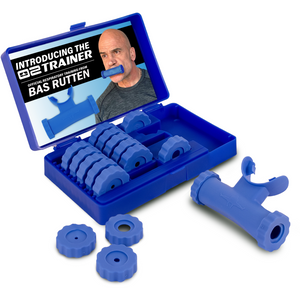Your Cart is Empty






NEW!! O2Trainer 2.0 System
$59.95
Here's what you get:
-
O2Trainer: Pinpoint your most important breathing muscles with the O2Trainer. This system makes sure that your diaphragm is getting a workout which will lead to better breathing and balance.
-
Resistance Caps: Caps range from 1mm to 14mm. Use the resistance caps to restrict airflow and build stronger breathing muscles.
- Instructions: Learn how to get the most out of your O2Trainer with the included "How To" pamphlet and links to our videos for proper technique.

FAQ
-
The O2 Trainer is a lightweight and portable breathing exercise device for lungs that help increase inspiratory (inhalation) muscle endurance. The breath trainer regulates air intake while improving oxygen efficiency during exercise. On one side, there is a cap with a flap. Leave this one on. Only remove for cleaning purposes. The cap with the flap has a plastic washer. If you hear air slipping in through that side, the washer is off. You can take it off, but its intended purpose is to stop excess salivation from occurring (which is a problem for every single Inspiratory Muscle Trainer you can buy). To cut back on this, swallow at the top of your inhale before you exhale. It also does not matter which side the cap is on, the device will work on both sides. The other side will have numbers on it. The numbers signify millimeters. 1 is 1 mm, 1.5 is 1.5mm, 2 is 2mm, etc. The recommended caps are 1, 1.5, 2, 3, 4, 5 and 6 for the breathing exercises. Some smaller sizes can create a whistling sound. To cut down on this, wipe the space with your finger and the sound should stop. Now that the number cap is on the device, when you inhale, the cap with a flap will close and force you to breathe from the numbered cap. Very basic, yet very powerful!
-
Before starting this exercise, make sure you are sitting in a stable chair, where your feet can touch the ground. Grab the bottom sides of the chair with your hands so you don’t raise your shoulders. Start by exhaling all air out of your body through your nose with the device situated within your mouth. Inhale fully through your mouth until you cannot inhale anymore, swallow, now exhale all air out of your mouth. If you start to feel dizzy, stop immediately. Here you can find the exercises, start with “the basic exercise” video: https://o2trainer.com/pages/bas-o2-breathing-exercises
-
Yes! Another exercise we recommend is leaning forward while sitting. Sit down. Put your legs at a 90 degree angle, lean forward on your legs and relax every muscle within your body, and only focus on your back muscles, at the lower part on your ribs, in the center, to expand. Stay in this position. Exhale completely, inhale completely with the device situated in your mouth, swallow, and now exhale out of your mouth and through the device. If you start to feel dizzy, stop immediately. Here are the videos for detailed instruction: https://o2trainer.com/pages/bas-o2-breathing-exercises
-
You should not hear air slipping from the cap with the flap. If you start to hear air coming from it,it could be the washer inside of the cap. To solve this, remove the cap, make sure the washer isn’t crooked or off center, and put the cap back on. You can test if this worked by plugging the numbered cap with your finger and inhaling like usual. A very small bit of sound can slip in, but if you do not like this, take the washer out. The washer is there to protect excess salivation until you are conditioned to the breathing technique. Taking the washer out will stop any sound from escaping.
-
Typically, the average person breathes by raising their shoulders. This only uses the top part of your chest and lungs. Four to six of these “shoulder raising” breaths equate to one “diaphragmatic breath”. In order to start changing how you breathe, we must first start conditioning your body to breathe by expanding the stomach, instead of breathing from the top part of the chest. Now, you will start focusing on pushing your stomach out as you breathe. Breathing from your stomach instead of your shoulders is known as “belly breath” or “belly breathing”. After being conditioned to this kind of breathing, which typically takes four to six weeks of practice, you should then begin to raise your breathing up by two inches. Focus instead of breathing from the center of your stomach, to the top portion of your stomach (the lowest part of your rib cage since that’s where your diaphragm is attached to). Breathing from this top portion of your stomach is known as “diaphragmatic breath” or “diaphragm breathing”. “Belly breathing” and “diaphragm breathing” are known as forms of “horizontal breathing”, whereas breathing from the top of your shoulders is known as “vertical breathing”.







